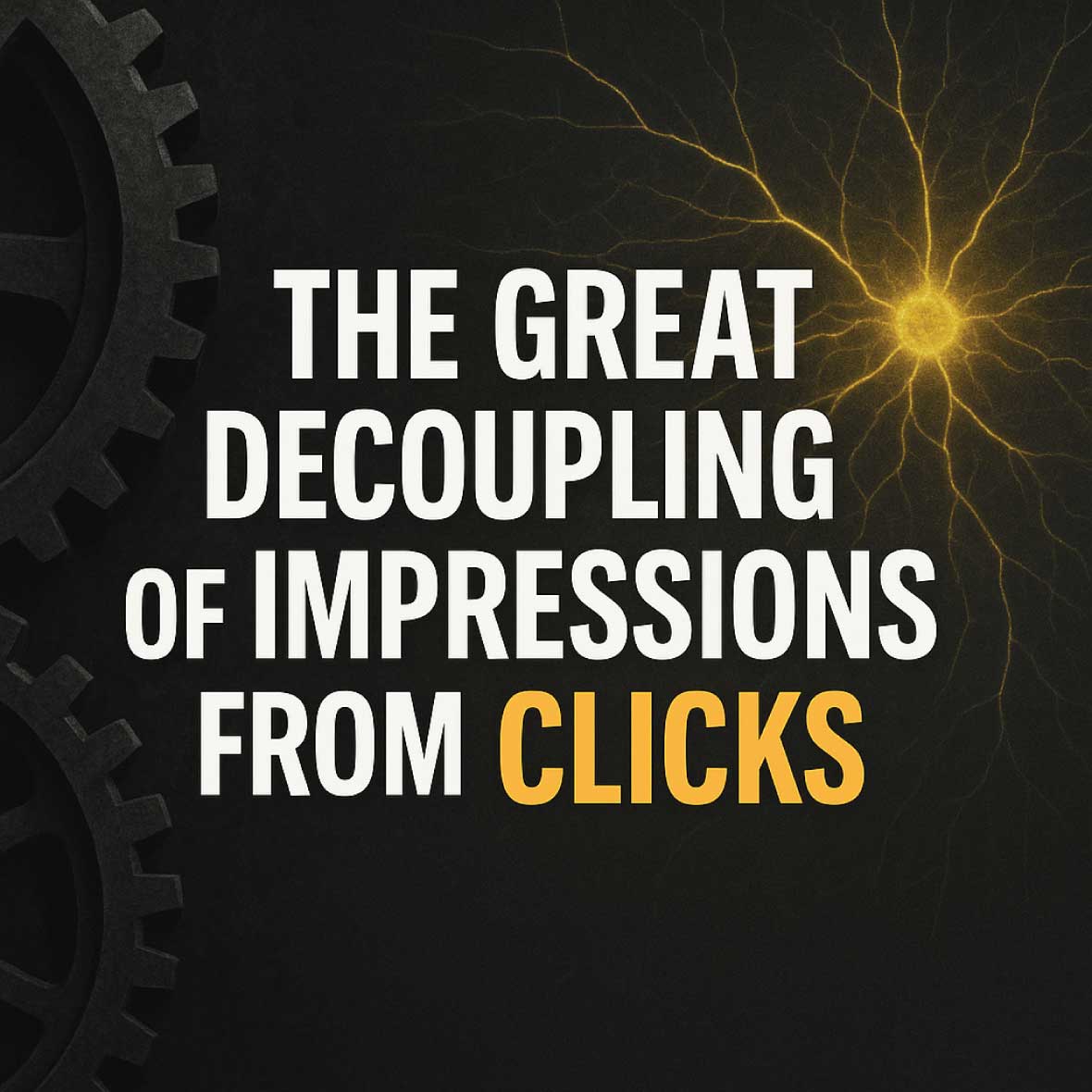AI answer boxes now end millions of searches before anyone visits your site. For CMOs, CROs, and CFOs, that breaks the old funnel math: no visits, no attribution, no revenue credit. This playbook rebuilds your measurement stack—so you can prove pipeline even when Google’s AI Overviews or ChatGPT do the talking.
The great decoupling of impressions from clicks
Two independent studies showed a 34–40 % drop in organic CTR after AI Overviews rolled out in 2024–25, with Ahrefs finding position-one CTR for informational terms cut by more than half in March 2025 (details). Zero-click searches climbed to 27.2 % of U.S. queries this spring, up three points year-on-year.
Those lost clicks don’t mean lost influence; they simply move the moment of persuasion into the AI answer itself. Revenue leaders must therefore track visibility as rigorously as visits.
New leading indicators that predict pipeline
Traditional metrics—rank, sessions, bounce—tell you little when prospects never land. Replace them with four visibility-centric KPIs:
- Share-of-answer (SoA). The percentage of AI answers in your topic cluster that cite your brand.
- Co-citation velocity. How often you appear alongside authority domains (Gartner, McKinsey) across AI answers and analyst write-ups.
- Sentiment-weighted visibility. NLP scoring of brand mentions inside AI outputs, gauging whether the model positions you positively.
- Conversation recall. Frequency at which users ask follow-up questions that include your brand after an initial AI answer.
Together these metrics forecast opportunity creation better than raw traffic because they occur earlier in the journey—often before any click.
Instrumenting AI-era attribution
1 · Google Search Console’s new AI Mode. In June 2025 Google began folding AI impressions and clicks into Performance reports SEJ coverage. While you can’t segment them perfectly, a daily export still flags AI traffic spikes that correlate with pipeline surges.
2 · Chat-style referrer strings. ChatGPT Search appends &utm_source=chatgpt; Perplexity uses ref=px-share. Capture both in web analytics to tag assisted sessions, then enrich with Clearbit or 6sense for firmographics.
3 · Conversation logs. Tools like SparkToro’s ChatMapper scrape public LLM answers and store the citations. Feed those logs to a warehouse so RevOps can join them with CRM touch-points.
4 · Explicit buyer surveys. Add a two-click poll to demo-request forms (“Where did you first hear of us?” → AI answer, analyst, colleague, etc.). These self-reported signals often surface AI influence you can’t see in clickstream data.
Building attribution paths without a visit
Classic first-touch models break when the first touch is invisible. Instead:
- Visibility-weighted multi-touch. Assign fractional credit to SoA exposure windows (e.g., 10 % per unique answer citation) blended with downstream engagement.
- Opportunity cohort matching. Group opportunities by the week their buying committee first appeared in Clearbit reveal logs; compare conversion velocity against periods of high SoA.
- Lift-over-baseline experiments. Temporarily
noindexa knowledge-card page and measure any drop in AI citations and opportunity flow from affected industries.
These models restore a line of sight from “brand mentioned in answer” to “revenue booked,” satisfying CFO scrutiny.
Presenting AI-era results to the C-suite
A RevOps-ready dashboard should marry visibility and revenue on one view:
- Top panel: SoA trend (rolling 28-day), co-citation velocity, sentiment index.
- Middle panel: AI impressions, assisted sessions, demo-request poll results.
- Bottom panel: Influenced pipeline ($), SQL volume, win-rate vs control.
Tools: Google Looker Studio for Search Console exports, a Snowflake warehouse for chat logs, and a CRM BI layer (HubSpot or Salesforce) for pipeline figures. Update weekly; brief monthly.
Continuous improvement when algorithms keep changing
LLM answer sets reshuffle daily, so adopt a sprint cadence:
- Weekly AI crawl. Use CrawlQ or Screaming Frog’s GPT-Enhanced plugin to log citations.
- Bi-weekly refresh. Update stats and alt text on pages that lost citations.
- Monthly experiment. Test one schema tweak (FAQPage vs HowTo), one headline rewrite, and one richer dataset embed.
- Quarterly authority push. Publish fresh benchmarks or partner POV pieces to earn new co-citations.
Your first 90 days
Days 1-14 — Audit AI visibility, pull Search Console AI Mode exports, baseline SoA.
Days 15-30 — Stand up chat-referrer tracking, integrate with your CDP, deploy buyer survey.
Days 31-60 — Publish five refreshed knowledge cards, launch one authority guest piece, start visibility-weighted attribution model.
Days 61-90 — Roll SoA-to-pipeline dashboard to execs; identify one campaign to pause and one to double down based on AI influence.
Key takeaway
Clicks may vanish, but buyer intent doesn’t. Measure visibility inside the answer box, link it to opportunity creation, and you’ll prove revenue impact even when the visit never happens.
Meta description (≤ 155 chars): Zero-click is the new default. Learn how CMOs and CROs can track AI answer visibility and tie it to pipeline—so finance still sees the revenue.
Target keywords: closed-loop reporting, AI revenue acceleration, RevOps architecture, zero-click search, answer-engine optimisation, pipeline measurement.

